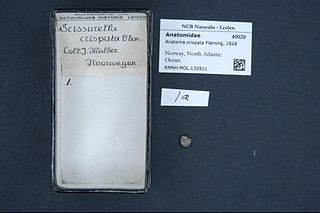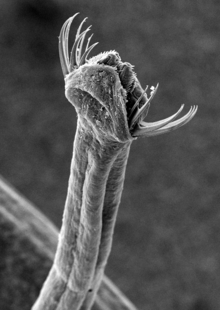
The Chaetognatha or chaetognaths are a phylum of predatory marine worms that are a major component of plankton worldwide. Commonly known as arrow worms, about 20% of the known Chaetognatha species are benthic, and can attach to algae and rocks. They are found in all marine waters, from surface tropical waters and shallow tide pools to the deep sea and polar regions. Most chaetognaths are transparent and are torpedo shaped, but some deep-sea species are orange. They range in size from 2 to 120 millimetres.

Marine invertebrates are the invertebrates that live in marine habitats. Invertebrate is a blanket term that includes all animals apart from the vertebrate members of the chordate phylum. Invertebrates lack a vertebral column, and some have evolved a shell or a hard exoskeleton. As on land and in the air, marine invertebrates have a large variety of body plans, and have been categorised into over 30 phyla. They make up most of the macroscopic life in the oceans.

Scomber is a genus of fish in the family Scombridae living in the open ocean found in Atlantic, Indian and Pacific Ocean. The genus Scomber and the genus Rastrelliger comprise the tribe Scombrini, known as the "true mackerels". These fishes have an elongated body, highly streamlined, muscular and agile. The eyes are large, the head is elongated, with a big mouth provided with teeth. They have two dorsal triangular fins, with some stabilizing fins along the caudal peduncle. The basic color is blue-green with a silvery white belly and a darker back, usually black mottled.

Anatoma crispata is a species of minute sea snail, a marine gastropod mollusk or micromollusk in the family Anatomidae.
Yoda purpurata is a species of acorn worm discovered 2.5 km below the surface of the Atlantic ocean, and was the first of the genus Yoda found. Ranging from 12 to 19 cm in length, it was named after the fictional character Yoda from the Star Wars franchise. It was the first known hermaphroditic member within the phylum. The other known hermaphroditic member of the phylum is Yoda demiankoopi discovered in 2021.

Sagittidae is a family of sagittoideans in the order Aphragmophora.

Ceutorhynchini is a true weevil tribe in the subfamily Baridinae.

Rhamphini is a weevil tribe in the subfamily Curculioninae.

Parasagitta elegans, the elegant arrow worm, is a small arrow worm in the family Sagittidae, previously named Sagitta elegans

Parasagitta is a genus of arrow worms in the family Sagittidae. At one time these arrow worms were classified in the genus Sagitta.
Alburnoides namaki, is a fish species of the family Cyprinidae, known from Iran. It can be differentiated from its cogenerates by differences in fin ray and vertebral counts, together with other morphological characters.
Alburnoides nicolausi, is a fish species of the family Cyprinidae, known from Iran. I can be differentiated from its cogenerates by differences in fin ray and vertebral counts, together with other morphological characters.
Alburnoides idignensis, is a fish species of the family Cyprinidae endemic to Iran. It can be differentiated from its cogenerates by differences in fin ray and vertebral counts, together with other morphological characters. The specific name is derived from the Sumerian name for the River Tigris, "Idigna".
Alburnoides gmelini, the Dagestan spirlin, is a fish species of the family Cyprinidae, known from the western Caspian coast of southern Russia. It can be differentiated from its cogenerates by differences in fin ray and vertebral counts, together with other morphological characters. The specific bane honours Samuel Gottlieb Gmelin, a Russian-German naturalist who travelled through the River Don area and the Caucasus region and along the western and southern Caspian Sea coasts between 1768 and 1774.
Alburnoides varentsovi is a fish species of the family Cyprinidae, known from Turkmenistan. It can be differentiated from its cogenerates by differences in fin ray and vertebral counts, together with other morphological characters.
Alburnoides petrubanarescui, is a fish species of the family Cyprinidae, known from Iran. It can be differentiated from its cogenerates by differences in fin ray and vertebral counts, together with other morphological characters.
Paraspadella is a genus of chaetognaths in the family Spadellidae. Paraspadella was originally considered as Spadella before a revision separated that genus into three genera: Spadella, Paraspadella, and Gephyrospadella, the last of which is now synonymised to Paraspadella. The initial division was based on previous knowledge of three groups of Spadella, in a similar manner in which Sagitta was divided into a family of genera. Paraspadella is differentiated from Spadella by the presence of disparate (digital) adhesive organs, present in the former to various degrees, but entirely absent in the latter.

Hermania scabra is a species of gastropods belonging to the family Philinidae.

Buskiella is a genus of pelagic polychaete annelids placed either in the family Flotidae or Flabelligeridae. In appearance, they are generally bluish or yellowish, depending on lighting conditions, and live exclusively in very deep water. They move by swinging their bodies from side to side, "rowing with [their] bristles." Species have nine to eleven chaetigers.

Flotidae is a family of pelagic polychaete worms, sometimes synonymized with Flabelligeridae, which they closely resemble. Other sources consider them the sister taxon to Flabelligeridae and closely allied to the latter group.










